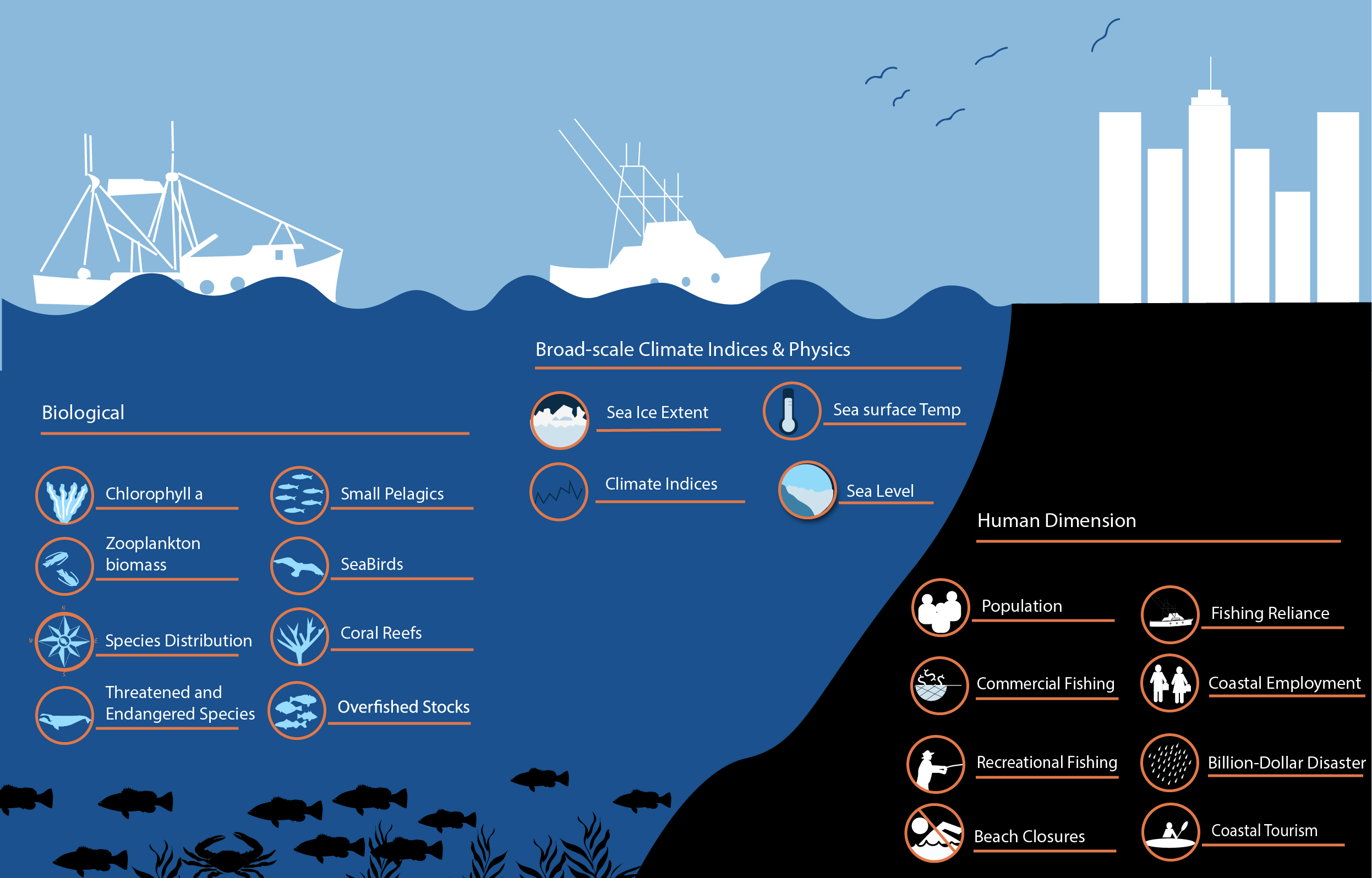
Marine ecosystem with icons for each of the key indicators that will be presented on this website
(click to enlarge)
The National Marine Ecosystem Status web portal provides the status of marine ecosystems across the U.S. and access to NOAA ecosystem indicator information and data. Check out this presentation to walk through how you can access information on this site.
Definition of indicators: Ecosystem indicators are quantitative and/or qualitative measures of key components of the ecosystem. Marine ecosystems provide food, jobs, security, well-being, and other services to millions of people across the U.S. Yet, marine ecosystems and the people that rely on them are facing increasingly complex challenges. Tracking the status and trends of ocean and coastal ecosystems is critically important to understand how these ecosystems are changing and identify potential issues.
Ecological
Understanding the status of key components of the ecosystem including human activities and well-being is essential because of the interlinkages between components. For example, broad-scale climate patterns such as the Pacific Decadal Oscillation (PDO) impact the temperature of the ocean.These broad-scale climate patterns interact with shorter scale climate to impact plankton by changing what species are present, how they grow, and where they are. Phytoplankton are often measured by chlorophyll a and serve the base of the food web. Primary consumers such as zooplankton and small pelagic fish eat phytoplankton. Larger fish eat zooplankton and other small fish. Marine mammals then feed on plankton, smaller, and larger fish. Humans consume seafood from across the ecosystem. Humans also rely on various ocean services such as tourism, seafood, and recreational activities for employment, recreation, and income.
Human Dimensions
Marine environments are important for people all across the country, but particularly so for people living in coastal communities. In the United States, coastal counties account for 39 percent of the total population (NOS). There are hundreds of thousands of ocean-dependent business establishments in these communities, employing millions of people and paying over $100 billion in wages annually. Employment in the ocean economy, including recreation, tourism, travel, and seafood industries, continues to grow faster than the U.S. economy as a whole.
Challenges to the Ecosystem
This ocean economy and human welfare more broadly are impacted by overfished stocks, hurricanes and other natural disasters whose costs can run into the billions of dollars, loss of threatened and endangered species, and beach closures. Overfishing is when the annual rate of catch of fish and other animals is too high and impacts businesses, the availability of seafood, and more. The number of weather and climate-related disasters exceeding 1 billion dollars, termed a billion-dollar disaster, has increased in the United States since 1980. Under the Endangered Species Act (ESA), a species is considered endangered if it is in danger of extinction throughout all or a significant portion of its range or threatened if it is likely to become endangered in the foreseeable future. These iconic species are important not only for coastal tourism such as whale watching but also critical for ecosystem functioning. Beach closures occur when beach water quality is determined to be unsafe for humans, which can have significant impacts on human health, the economy, and the ecosystem.
These key ecosystem components, from sea surface temperature to coastal tourism, are interconnected. Therefore, it is important to track the status and trends of these components to understand the current state of U.S. marine ecosystems.
Understanding the Gauge plots
The gauge plots that accompany the indicator time series are meant to reflect the current status of that ecosystem component, at the regional or national level. The numerical scores are determined as the percentile rank of the average (mean) value of that indicator over the last five years of the time series, relative to the series as a whole. The values typically represent quantitative score, with more desirable conditions in the darker blue. Thus, some gauges are "right-handed" with the higher values being in darker blue, whereas other gauges are "left-handed" with lower values being in darker blue (indicating that lower values are preferable). In some instances (e.g. climate measures), the scores represented are unitless and are presented as two-way gauges, indicating that either high or low scores are observed, implying neither higher nor lower values are necessarily preferred.

Lefthand gauge Righthand gauge Two-way gauge
Understanding the Time series plots
Time series plots show the changes in each indicator as a function of time, over the period 1980-present. Each plot also shows horizontal lines that indicate the median (middle) value of that indicator, as well as the 10th and 90th percentiles, each calculated for the entire period of measurement. Time series plots were only developed for datasets with at least 10 years of data. Two symbols located to the right of each plot describe how recent values of an indicator compare against the overall series. A black circle indicates whether the indicator values over the last five years are on average above the series 90th percentile (plus sign), below the 10th percentile (minus sign), or between those two values (solid circle). Beneath that an arrow reflects the trend of the indicator over the last five years; an increase or decrease greater than one standard deviation is reflected in upward or downward arrows respectively, while a change of less than one standard deviation is recorded by a left-right arrow.

The following are members of NOAA Research Council’s Ecosystem Indicators Working Group who developed this website and the status reports. Should you have any questions, want to report an error or correction, or request that we consider adding links to additional marine ecosystem data, please let us know at NMFS.EIWG@noaa.gov
Jason Link -- NMFS
Bruce Moravchik - NOS
Hendrik Tolman - NWS
Stephanie Oakes - NMFS
Chris Kelble - OAR
Monique Baskin - OAR
John Christensen - NOS
Steve Gittings - NOS
Scott Cross - NESDIS
Geret DePiper - NMFS
Theresa Goedeke - NOS
Ellen Spooner - NMFS
Gabrielle Canonico - NOS
Avi Litwack - NMFS
Barbara Ambrose - NESDIS
Will Klajbor - Knauss fellow